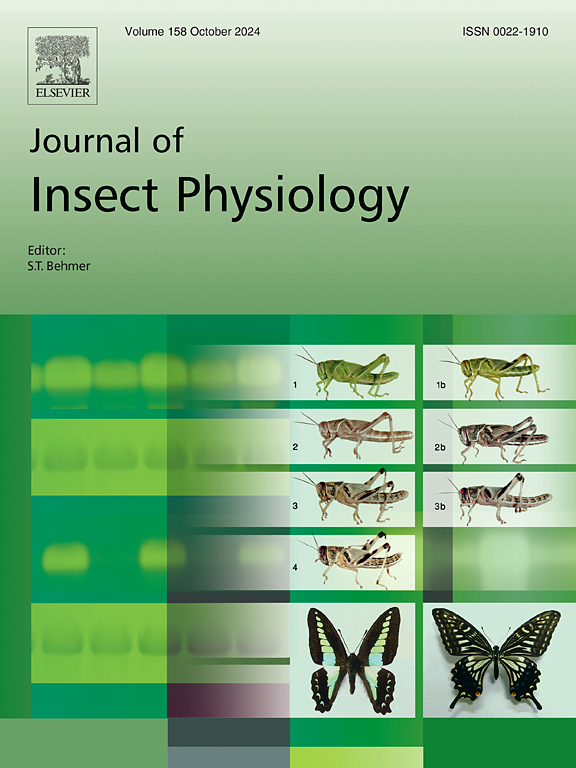Transcriptional activation of BmToll9-2 to exogenous dsRNA in the larvae of Bombyx mori
IF 2.3
2区 农林科学
Q1 ENTOMOLOGY
引用次数: 0
Abstract
The Toll pathway plays a crucial role in insect innate immunity, functioning through pattern recognition receptors (PRRs) that detect pathogen associated molecular patterns (PAMPs). Previous studies on BmToll9-2 have primarily investigated its role in sensing bacterial pathogens and activating antimicrobial peptides. In this study, we aimed to investigate the transcriptional regulation of BmToll9-2 in response to exogenous double-stranded RNAs (dsRNAs) in silkworm (Bombyx mori) larvae. Various delivery routes for dsRNA-triggered activation of BmToll9-2 were explored. Quantitative real-time PCR (qRT-PCR) assays revealed significant up-regulation of BmToll9-2 in the midgut, fat body, and epidermis following dsRNA injection. In contrast, oral administration of dsRNA failed to induce a transcriptional response. In vitro stability assays demonstrated that dsRNA was rapidly degraded in midgut fluid (within 10 min) but remains stable in the hemolymph for an extended period (up to 6 h). In vivo detection of dsRNA further confirmed its rapid digestion through feeding and the longer retention through injection. Additionally, infection with B. mori cytoplasmic polyhedrosis virus (BmCPV) also induced BmToll9-2 expression, suggesting a link between dsRNA viruses and Toll pathway activation. Our findings suggest dsRNAs as potential PAMPs for Toll receptor signaling, highlighting the longer persistence of dsRNA in the hemolymph as a significant factor in the transcriptional response and emphasizing the role of BmToll9-2.

家蚕幼虫BmToll9-2对外源dsRNA的转录激活。
Toll通路通过模式识别受体(PRRs)检测病原体相关分子模式(PAMPs),在昆虫先天免疫中起着至关重要的作用。以往对BmToll9-2的研究主要是研究其在病原菌感知和抗菌肽激活中的作用。在这项研究中,我们旨在研究BmToll9-2在家蚕(Bombyx mori)幼虫中对外源双链rna (dsRNAs)的转录调控。探索了dsrna触发的BmToll9-2激活的各种递送途径。实时荧光定量PCR (qRT-PCR)结果显示,注射dsRNA后,小鼠中肠、脂肪体和表皮中BmToll9-2表达显著上调。相比之下,口服dsRNA未能诱导转录反应。体外稳定性试验表明,dsRNA在中肠液中迅速降解(10 min内),但在血淋巴中保持较长时间稳定(长达6 h)。dsRNA的体内检测进一步证实了其通过喂养消化快,通过注射滞留时间长。此外,家蚕胞质多角体病毒(BmCPV)感染也诱导BmToll9-2表达,提示dsRNA病毒与Toll通路激活之间存在联系。我们的研究结果表明,dsRNA是Toll受体信号传导的潜在PAMPs,强调了dsRNA在血淋巴中作为转录反应的重要因素的持久性,并强调了BmToll9-2的作用。
本文章由计算机程序翻译,如有差异,请以英文原文为准。
求助全文
约1分钟内获得全文
求助全文
来源期刊

Journal of insect physiology
生物-昆虫学
CiteScore
4.50
自引率
4.50%
发文量
77
审稿时长
57 days
期刊介绍:
All aspects of insect physiology are published in this journal which will also accept papers on the physiology of other arthropods, if the referees consider the work to be of general interest. The coverage includes endocrinology (in relation to moulting, reproduction and metabolism), pheromones, neurobiology (cellular, integrative and developmental), physiological pharmacology, nutrition (food selection, digestion and absorption), homeostasis, excretion, reproduction and behaviour. Papers covering functional genomics and molecular approaches to physiological problems will also be included. Communications on structure and applied entomology can be published if the subject matter has an explicit bearing on the physiology of arthropods. Review articles and novel method papers are also welcomed.
 求助内容:
求助内容: 应助结果提醒方式:
应助结果提醒方式:


